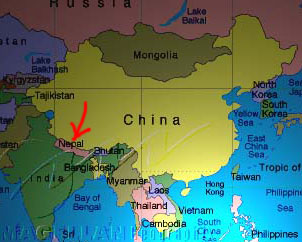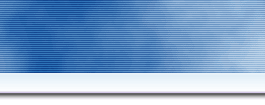|

KEY FACTS
Official
name:
Nepal Adhirajya (The Kingdom of Nepal)
Area:
147,181 square km
Population:
23.21 million (2001)
Capital:
Kathmandu
Official language:
Nepali
Currency:
Rupee (NRs) = 100 paisa
Exchange rate:
NRs76.73 per US$ (Nov 2002)
GDP per capita:
US$241 (2001)
GDP real growth:
4.80% (2001)
Labour force:
11.50 million (2001)
Unemployment:
20.00% (2000)*; 47.0% (2000) (underemployed); 7.0% (2000)
(urban)
Inflation:
2.40% (2001)
Balance of trade:
-US$832.00 million (2001)
Foreign debt:
US$2.70 billion (2001)
Visitor numbers:
376,507 (2000)
Annual FDI:
US$6.00 million (2001)
* estimated figure
top
Historical
profile
1769
Prithui Narayan Shah, the ruler of the House of Gorka, succeeded
in unifying the diverse kingdoms between Mogul India and
Tibet.
1951
A popular revolution led by the Nepali Congress Party (NCP)
overthrew the Rana family, which had been de facto rulers
of Nepal since 1851. King Tribhuvan was restored to power.
A limited constitutional monarchy was established.
1959
King Mahendra, who succeeded his father, promulgated the
first constitution, providing for a bicameral parliament.
1959
The country's first elections resulted in a victory for
the NCP.
1960
Following a royal coup in December, the King dismissed the
cabinet and dissolved parliament.
1961
A royal decree banned political parties.
1962
King Mahendra introduced a new constitution, which reasserted
absolute royal power, provided for a non-party system and
a prime minister nominated by the King.
1972
King Mahendra died and was succeeded by his son Birendra.
1980
Government issued a decree amending the constitution. New
provisions provided for direct elections in 1981, the first
since 1959, although still on a non-party basis.
1981
Surya Bahadur Thapa was elected Prime Minister in June.
1983
Thapa was ousted as Prime Minister after a no confidence
motion. He was succeeded by Lokendra Bahadur Chand.
1990
After protests in Kathmandu between February and April,
led by the NCP and the Communist Party of Nepal-United Marxist-Leninist
(CPN-UML) parties, the King dissolved the panchayat (non-party)
system and lifted a 30-year ban on political parties.
1997
On 12 March the King effected some changes in the Council
of Ministers and expanded the cabinet to 23 ministers and
nine ministers of state.
1998
Prime Minister Koirala resigned and was then re-appointed
by the King on 23 December. He put together the sixth coalition
government since the last general election in 1994. The
King finally dissolved parliament in January 1999.
1999 Krishna Prasad Bhattarai became Prime Minister.
2000
Prime Minister Bhattarai resigned on 16 March due to internal
opposition within the NCP, and Girija Prasad Koirala was
elected in his place. Koirala was appointed Prime Minister
by the King for the fourth time on 20 March. In December,
56 of the NCP's 113 legislators signed a no-confidence motion
against the Prime Minister.
2001
The rebel Communist Party of Nepal, which wants land reform,
conducted lightning raids both in the countryside and in
Kathmandu. On 1 June, Crown Prince Dipendra killed his parents
and six other members of the royal family before turning
the gun on himself. Three others were injured. The State
Council named Dipendra as King, but he subsequently died,
and his uncle, Prince Gyanendra, who had been acting as
regent, was declared King. There was rioting in the streets
of Kathmandu.
top
Political
structure
Under the 1990 constitution, the powers of the monarch were
considerably diminished. It provides for a bicameral legislature
comprising a popularly and fully elected 205-member Pratinidhi
Sabha (House of Representatives) and an indirectly and partly
elected 60-member Rashtriya Sabha (State Council).
The cabinet has 25 ministers, and the number of ministries
has been cut from 27 to 18.
Last elections
3 and 17 May 1999 (general)
Next elections
2004
Political parties
Ruling party
Nepali Congress Party (NCP)
Main
opposition party
The Communist Party of Nepal-United Marxist-Leninist (CPN-UML)
party
Population
The annual population growth rate was 2.5 per cent between
1980-99, and is projected to be 2.1 per cent between 1999-2015).
Life expectancy is 58 years. The infant mortality rate is
77 deaths per 1,000 live births.
Population density is 154 inhabitants per square km.
Ethnic make-up
A mixture of Indo-Caucasian and Tibeto-Mongoloid tribesmen,
but also including a number of Tibetan refugees.
Religions
Hinduism (90 per cent), Tibetan Buddhism (5.3 per cent),
Islam (2.7 per cent). Nepal is the only officially Hindu
Kingdom in the world: the constitution provides for freedom
of religion, though encouraging conversion remains illegal.
Main cities
Kathmandu, capital (estimated population 960,000), Pokhara,
Janakpur, Bhaktapur, Biratnagar, Birganj, Bhairahawa, Dharan,
Hetauda, Nepalganj, Dhangadhi
Languages
spoken
Nepali (Eastern Pahari) is the official language; Maithir,
Bhojpuri, Hindi, Bengali spoken; English is sometimes spoken
in urban centres.
top
Media
Press
Dailies: Nepal News.Com (http://www.nepalnews.com)
has links to daily, weekly, fortnightly, and other newspapers
of Nepal. English language dailies include Kathmandu Post
and The Rising Nepal. Other Nepali dailies are Gorakhpatra,
Kantipur, Mahanagar, Samacharpatra and Sandhya Times.
Weeklies: The People's Review carries excerpts
from the English-language weekly published in Kathmandu.
Local Nepali language weeklies include Janmabhumi Saptahik,
Bimarsha, Deshantar Dristi and Janadharna. English language
weeklies are Spotlight, Sunday Despatch, Sunday Post, Telegraph,
Independent and Nepali Times.
Business: Business publications include Nepal Travel
Trade Journal, Casino Time and New Business Age.
Periodicals: The Cyber Post is a fortnightly publication.
Explore Nepal is a local English newspaper published fortnightly.
Monthly publications include Apsara, Kamana, Nepal Traveller,
Nepal Travel Trade Reporter and On Time.
Broadcasting
Radio: Radio programmes are broadcast in Nepali and English.
Television: TV transmissions in English and Nepali in the
Kathmandu Valley. TV programmes are also transmitted in
Pokhara, Biratnagar and Birganj.
top |






